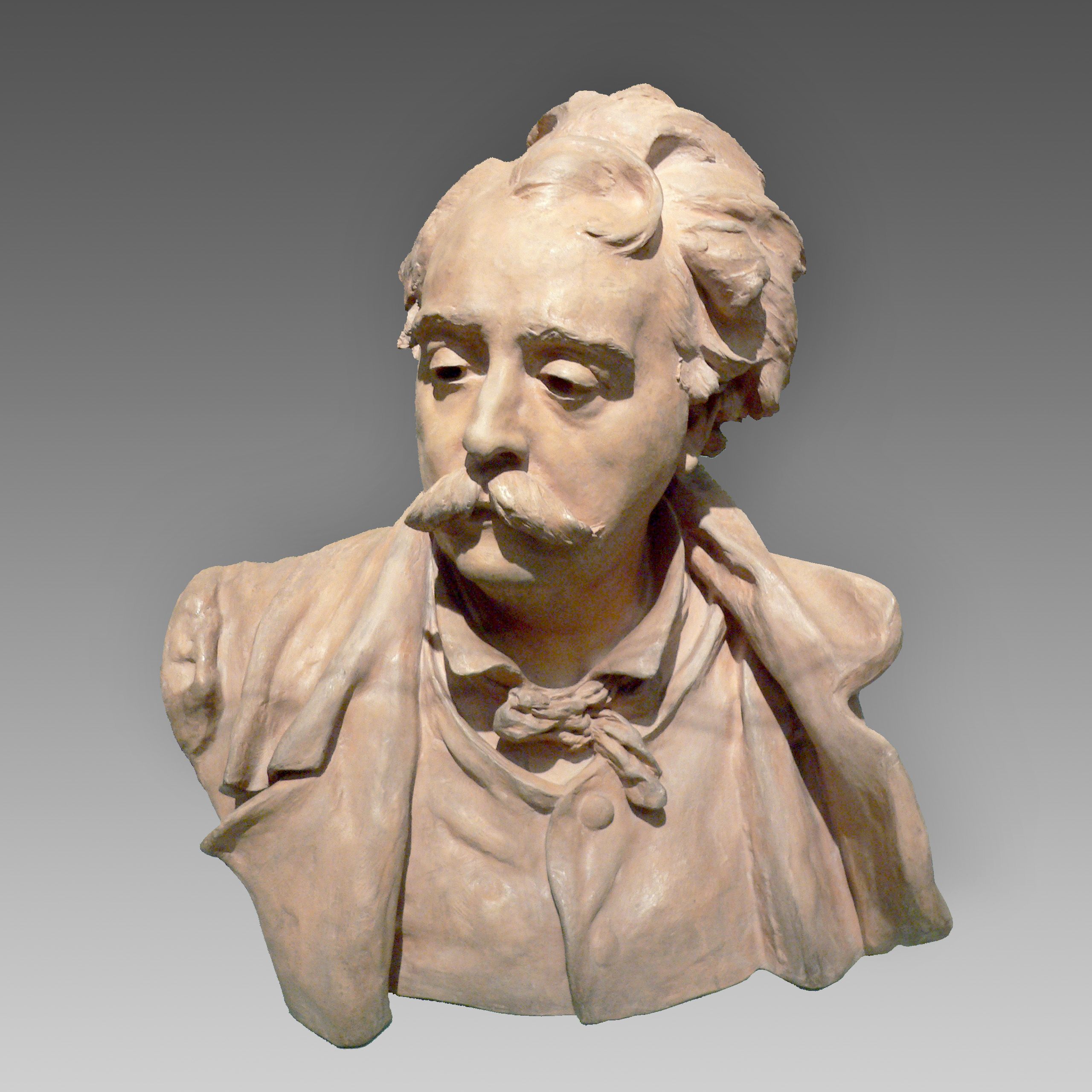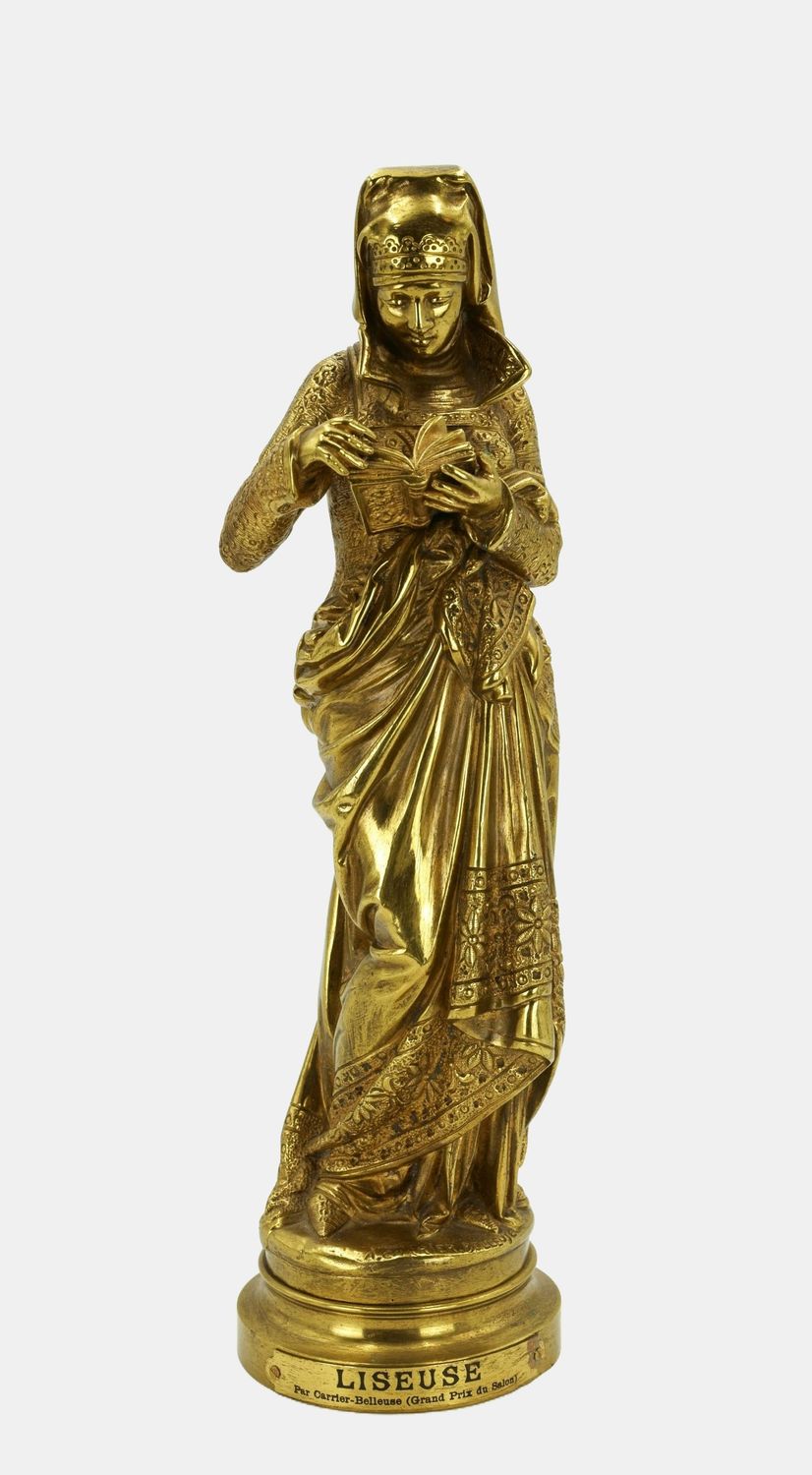Carrier-Belleuse, Albert-Ernest (1824-1887), Reading Woman, c. 1880
Albert-Ernest Carrier-Belleuse(1824 Anizy-le-Château - 1887 Sèvres), Reading Woman , around 1880. Polished bronze mounted on a cast base. 33 cm (total height) x 9 cm (length) x 9 cm (depth), weight 2.97 kg. Signed on the plinth “A.[lbert-Ernst] CARRIER.BELLEUSE], titled ‘LISEUSE’ on the base plate and inscribed ‘Par Carrier-Belleuse (Grand Prix de Salon)’.
- The front edge of the plinth with a small bumped area, slight traces of oxidation in the breast area, somewhat rubbed in places, overall in very good condition for its age
- The golden glow of imagination -
Albert-Ernest Carrier-Belleuse takes us back to the time of the Très Riches Heures, the Book of Hours of the Duke of Berry, created by the Limbourg brothers between 1485 and 1489. The reading woman seems to have stepped directly out of the world of the Book of Hours, reflecting on the act of reading itself. Her gown, decorated with extremely rich brocade embroidery, which requires the greatest precision in the bronze casting, identifies her as an elegant court lady. She is engrossed in reading a book, which may be a Book of Hours, as indicated by its richly decorated cover and format. While the lady holds the book with one hand and the open pages with her thumb, the fingers of the other hand are already turning the next page, thus illustrating the process of reading. If her face radiates a calm, almost motionless beauty, the cascading folds convey the inner movement to the outside. Like a saintly figure of the time, she has gathered her outer garment with her forearm, creating elegant drapery that also dramatizes the figure.
Carrier-Belleuse experimented with galvanic processes to silver and gild the surfaces of bronze sculptures. The Woman Reading, for which the artist was awarded the Grand Prix of the Paris Salon, is an outstanding example of this innovative technique. The golden appearance evokes the lost "sacred" time visualized by the reading woman. At the same time, the pictorial representation of reading opens up the realm of the imagination.

Auguste Rodin, Büste von Albert-Ernest Carrier-Belleuse, 1882
Foto David Monniaux /
CC-Lizenz
About the artist
After an apprenticeship as a chaser and goldsmith in Paris, Albert-Ernest Carrier-Belleuse began studying at the Ecole des Beaux-Arts under Pierre-Jean David d'Angers in 1840, but soon turned his back on academic art and transferred to the Petite École, which became the École nationale des arts décoratifs in 1877. In 1848, he moved to England and worked as a designer for the famous Herbert Minton porcelain and faience factory in Stoke-upon-Trent. He also designed for Wedgewood and Copeland, the cast iron company Coalbrookdale, and the furniture company Graham & Jackson. Even after returning to Paris in 1855, he continued to provide models for British manufacturers throughout his artistic career.
From 1857, he was a regular exhibitor at the Paris Salon and quickly became a sought-after artist. Napoleon III acquired the marble statue "Bacchante", presented in 1863, for the Tuileries Gardens (now in the Musée d'Orsay) and praised Carrier-Belleuse as "notre Clodion", referring to the most admired sculptor of the 18th century in France, Claude Michel gen. Clodion (1738-1814). The emperor's appreciation led to further state purchases. In 1867, the "Messiah" from the Salon, which had been awarded the Medal of Honor, was purchased for the St-Vincent-de-Paul Church in Paris, which also earned the artist the Cross of the Legion of Honor. "The Sleeping Hebe of 1869 was even commissioned by the state and is now in the Musée d'Orsay.
Carrier-Belleuse also created numerous portrait busts of contemporary and historical figures. He portrayed Napoléon III, Eugène Delacroix, Honoré Daumier, Théophile Gautier and his great idol Jean-Antoine Houdon, among others. His oeuvre also includes monumental memorials such as the "Maréchal Masséna" in Nice (1869) and the equestrian monument to the unification of Wallachia, Transylvania and Moldavia in Bucharest (1876).
In 1871, Carrier-Belleuse and Auguste Rodin fled from the Paris Commune to Brussels, where they created a frieze for the newly built stock exchange under his direction. After his return to Paris, one of his most important artistic activities was undoubtedly his creations for the New Opera of Charles Garnier, with whom he was friends, as well as with Jean-Baptiste Carpeaux. From 1875 until his death in 1887, Carrier-Belleuse was artistic director of the Sèvres porcelain factory, which flourished under his leadership. Auguste Rodin also worked for Carrier-Belleuse in Sèvres from 1877 to 1883, and Rodin created a terracotta bust of him in 1882.
In addition to his artistic innovations, which opened academic classicism to a new naturalistic sensuality, Carrier-Belleuse also developed technical innovations. He experimented with galvanic methods of finishing bronze sculptures.
In 1885, an incurable eye disease gradually blinded him. In the same year, the artist, who had been named a Knight of the Legion of Honor in 1867, was made an Officer of the Legion of Honor.
Albert-Ernest Carrier-Belleuse signed his works "A. Carrier" and from about 1868 "A. Carrier-Belleuse".

